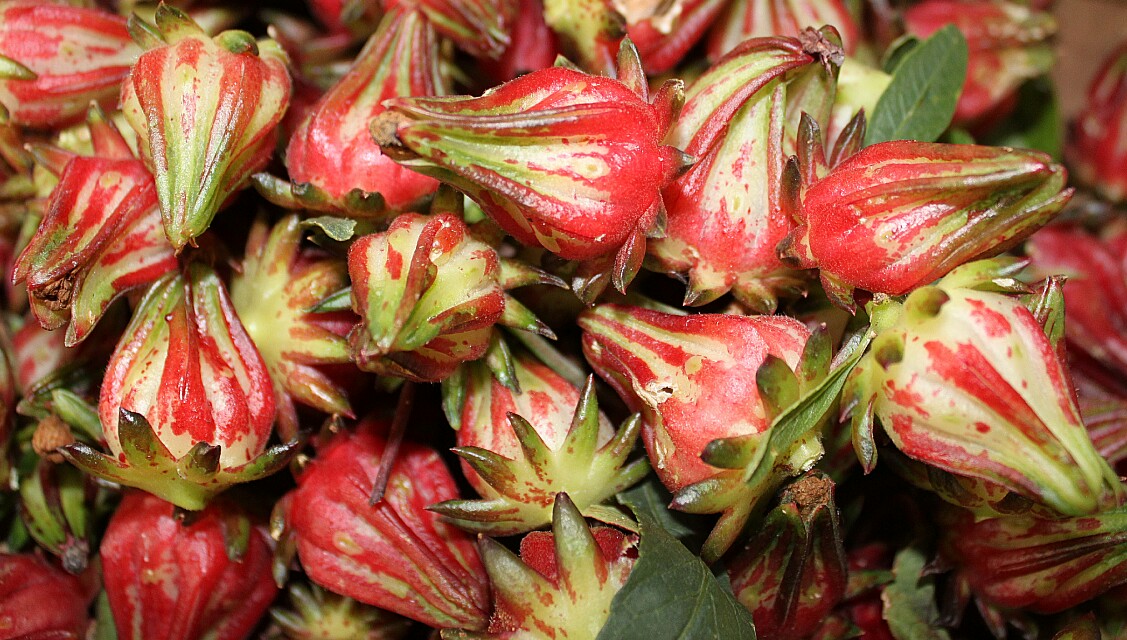I was surprised to discover that rosella, or roselle (Hibiscus sabdariffa), is pervasive throughout Zambia because it was originally a species of hibiscus native to the west of Africa.

Then a Zambian friend told me that rosella, known in some of the local dialects as lumande, was long ago smuggled in from Angola, our western neighbor, after it was listed as prohibited for being highly invasive. The legend goes that a young woman from the Luvale people, a tribe that straddles the border of both countries, so coveted the rosella seeds she unearthed in Angola, she plaited them into her hair where no one would find them when she crossed back home to Zambia. That it was invasive is without question: rosella is now to be found growing in most gardens the length and breadth of this country.
The native Zambians love to eat the plant’s peppery leaves, which they fry or boil together with fish or chicken, usually combined with a tomato and onion relish. It’s a great accompaniment to their traditional staple, nshima, or maize meal.

Like so many wild edibles, rosella is filled with goodness. It’s brimming with phytochemicals, and is held up for its antihypertensive and antioxidant properties.
Chris and I find a rosella tea infusion, which steeps into the color of claret, very comforting. We drink it either hot or cold. On its own rosella is puckery so we add a teaspoon of honey, while mint, ginger and lemon juice are all terrific additions. It also makes a tasty, firm jelly, which we like to eat with lamb, as well as a syrup for desserts and a molasses. I will be sharing these rosella recipes with you in later posts.

If using rosella fruit for an infusion it’s best to dry them first. After picking they are prone to breaking down fast, especially in a hot climate, and this way your supply lasts much longer. We separate each sepal, removing the large seed, and then leave them outside in the sun to dry for between one to two weeks, depending on the time of year. Afterwards, we store the dried rosella in an airtight container and, because it’s better fresh, we grind it into a powder as and when we want to use it. We pour boiling water over two teaspoons of rosella powder in a strainer, leave it to infuse for a few minutes, and then add the honey. (Be aware that it tends to leave behind a residue at the bottom of your cup.)
Different species of rosella–also referred to as roselle, wild hibiscus or Jamaican sorrel–are grown and used in cuisine in the Caribbean, Latin America, the Middle East, Australia, Asia and throughout most of Africa.


15 Comments
As a child I spend many school holidays with my grandparents in Zambia. i have fond memories of Rosella jelly/jam that my grandmother used to make for us. Yummy!
I agree, Ann. It is delicious. I will be posting on rosella jelly in due course. Thanks for your interest! Annabel
Yep, remember picking prickly rosellas and the jelly. The infusion looks amazing! Bet you could dye things with that 🙂
Hi Di … it’s actually imported to Europe and the United States for creating food coloring. So yes, it does make a good dye!
My parents’ maid (Evalina) used to make rosella jelly and give it to us for Christmas (and if she didn’t have jelly, she would give us sweet potatoes 🙂 )
Yum, Carol! On both counts … 🙂
[…] My Zambian assistant, Adelina Banda, later let on that sindambi was the Lozi word for rosella, the ubiquitous wild edible about which I wrote in July. So, no surprises there. I, on the other […]
There is nothing better than Rosella Jelly for Pork dishes or even Turkey. I have always been curious about the plant as I am not familiar with it. Thanks for the info Annabel.
It’s my pleasure, Chitaiti. I agree. Rosella jelly is yummy with pork and turkey. Thanks for your interest in my blog. All the best, Annabel
[…] edible, packed with loads of different flavors, and is really, really good for you. (Read about rosella in a previous post I wrote last […]
[…] in expanding our organic garden, teaching me about the indigenous plants, such as sindambi, along the way. Together we tested recipes, fusing together the wild food with our garden […]
I actually do not mind eating it every day on my meals with Nshima and fried or dried fish. I like the rain season the most as that is when it grows uncontrollably.
I love sindambi, too. It’s healthy and so delicious! Thank you, Grace, for your interest and support … 🙂
Yep very delicious
Yes indeed!
Comments are closed.